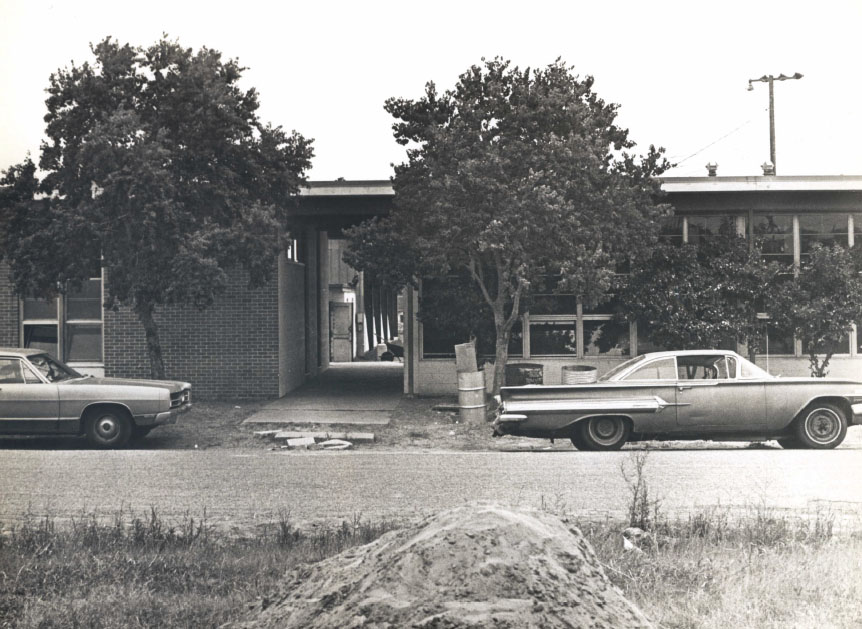Photo of Lincoln High School provided by Project HOLD.
by Nicole Farrell, senior editor
Note: This piece is a continuation of our print story on the integration of A&M Consolidated and Lincoln High schools, Vol. 19, No. 4, pp. 10-11. The print issue can be accessed here.
Desegregation of College Station schools had already begun three years prior in a stair-step method, beginning with one first grade class, and then every class underneath them. 33 black students had filed a lawsuit in 1962 against Superintendent W.T. Reidel and the Board of Trustees, asserting that integration was not happening fast enough.
Anne Boykin, former Heritage Programs coordinator for the City of College Station, Project Historic Online Library Database (HOLD) coordinator, and student herself at the time, has researched and talked with the key individuals who catalyzed change in fifties and sixties College Station.
Her father, an Agricultural Economics professor at Texas A&M University was part of an underground organization named the Brazos Bottoms Philosophical Society. A group of men, both black and white, met secretly to discuss pressing social issues at A&M in the fifties, mainly desegregation of the A&M Campus.
A few years later, in 1958, a new activist organization called Citizens Fellowship began to push for integration. Texas A&M biology professor Dr. Frederick H. Kasten was extremely influential as president and spokesperson. He started his resolutions with smaller issues like equal postal service and fire hydrants. At the time, residents of primarily black neighborhoods were required to pick up their mail at the post office and did not have access to fire hydrants in case of an emergency.
The Supreme Court tried Brown v. Board of Education in 1954 and ruled that segregation in schools violated the 14th Amendment. In 1957, laws in Texas established that state funding could not be distributed to segregated schools. The rest of the country and state was making civil rights progress, but in some important areas, College Station was behind the times.
Churches were first encouraged to integrate in the area. Many ministers and leaders played vital roles in the push for equal and integrated schools as well.
In 1964, Texas A&M admitted its first black student. Boykin recalls her father coming home for lunch one afternoon around that time, quiet and upset:
“He said, ‘Before we start, I have to say something. I never thought I’d see the day.’ He said, ‘Today we had a staff meeting. Our department head called us together to tell us about A&M opening to African-American students.’ I said, ‘Well, Daddy, that’s a good thing!’ and he said, ‘Yeah, it’s a good thing. But this is what he [the department head] told us.’” Boykin remembers her father as being upset and almost to tears. He continued, repeating the words his department head had said.
“‘This is what he said, ‘I just want y’all to know that I never thought I’d see the day they’d let chocolate drops on campus.’”
There was definitely “animosity among faculty and some students at Texas A&M,” concerning the admission of black students, Boykin said. However, negative opinions were outweighed by a majority that welcomed the progressive changes.



Good job, Nicole!
My Family (CP & Cruz Martinez ) had Transferred into The AMC School District back in 1954 I believe, and was the FIRST Hispanic Family to become Students there !!
Although, Our Neighbors the (Pete Rodriguez family) also entered @the Same time from Bryan,Texas !!
Nice work, Ms. Farrell. Jamie Bassett and I played on the tennis team at Consol; Leroy Clark & I were starters for the basketball team in the ’68 – ’69 season. I didn’t know William Roy back then, but have gotten to know him a little during the run up to our reunion in April. He’s a great guy, and I have truly enjoyed our conversations. Rasteen Wilson was a tremendous track star for Consol and a great team mate to the others on that team. 1966 was filled with interesting times for all of us; I think it benefited us that the high school was still smallish in student population (about 600 for 9th-12th grades). There were bad white kids that we stayed away from and there were black kids we learned to stay clear of, too. I can honestly say that my friendship with James Nichols, a team mate on the basketball team with me in 1967 – 1968 came to my rescue after the football game we lost to Brenham at Tiger Field. Suffice to say, 4 Brenham students felt they needed to beat me up. Nichols and a friend of his who had joined us in the hot summer days to shoot hoops in Tiger Gym stepped up and told me not to worry. They not only ran the 4 Brenham boys off; they made sure I was safe to go home. James Nichols taught me how to rebound, and that served me well in my senior year. Nowadays, I look back on those memories we made together and know that we were akin to being brothers, and I am a better person for it. Thanks for writing about those times.
Wow. My first grade class room. What fond memories. Though I was quite young I remember being visibly upset upon having leave my school. It was so much as being with knitted family.
Nicole, this was a daunting task and you performed very well. Great writing! This story needs to be read and reread to remind us that good people in our community persevered to make A&M Consolidated a school open to all. Dr. Kasten is still alive. I plan to share this with him. He will be very pleased to know that his legacy lives on. I wish Paul Garvin (CHS ’67) was with us today to see his story in print. More information can be found in the Project HOLD (Historic Online Library Database) archive from the City of College Station. HOLD.cstx.gov Once there, click on the “4 Newsletters” folder and go to Moment in History Newsletters/January 2007.
Pingback: Katy Perry’s ‘Birthday’ – Hailey, Daley